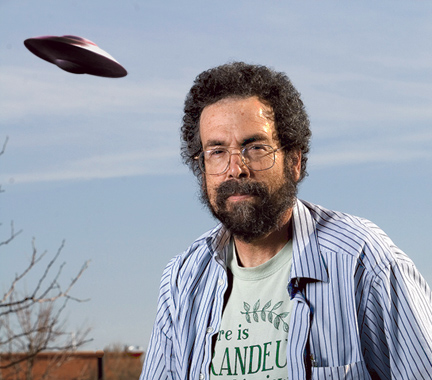New Mexico, land of two national laboratories, is home to lots of scientists. Whether employed developing supercomputers, testing explosives or doing autopsies on extraterrestrial crash victims, there are plenty of PhDs walking around.But New Mexico native David Thomas is not your ordinary egghead. He’s also one of the country’s top skeptical investigators. Thomas has degrees in physics and mathematics from New Mexico Tech, where he develops earthquake-detection equipment. He also teaches a course on critical thinking and distinguishing science from pseudoscience. Oh, and he plays mean bass in local act Vigilante Band. He’s president of New Mexicans for Science and Reason (NMSR), which tackles all manner of curious claims, from the world-famous Roswell crash to creationism to contrails (or chemtrails, those white lines in the sky following airplanes, claimed by conspiracy theorists to be toxic). “We also look into fringe science and paranormal claims,” he says. In fact, Thomas and his group have offered to test people with alleged powers right here in Albuquerque, including psychics and dowsers. Unfortunately, Thomas says, “at the last minute they chicken out, and they really don’t want to have a scientific test of their paranormal powers for one reason or another.” Thomas is perhaps best known for applying his knowledge of mathematics and computers to the Bible Code, the hidden messages supposedly found in holy texts. The code was the subject of the 1997 best-selling book The Bible Code , by Michael Drosnin. Thomas demonstrated that the patterns Drosnin and others were finding were artifacts that resulted from “data mining.” That is, if you run a computer program through enough massive pieces of text (whether the Bible or War and Peace or Moby Dick ), looking for enough patterns (every 10 th letter, every 12 th letter, etc.), it will eventually spit out some words and jumbly sentences that could be interpreted to make sense. It’s the sort of thing that the veritable room full of monkeys with typewriters would be able to generate, given enough time (and no breaks to write George W. Bush’s speeches). New Mexico’s biggest mystery is of course the Roswell crash, but there are several lesser-known cities that also claim to have received extraterrestrial visitors at one point or another, including Aztec. “The Aztec story really took off in 1950,” Thomas says, “when a writer—a Hollywood reporter named Frank Scully—published a book called Behind the Flying Saucers. It was the first full-length American book on flying saucers. It described 16 humanoid bodies that were recovered together, along with their undamaged spacecraft. Scully had informants who told him that the disc landed near Aztec, N.M., back in March of 1948.” The disc that was allegedly recovered was said to have been 99.99 feet in diameter.Scully’s best seller stated that the dead alien bodies and spacecraft were hauled off to a top-secret U.S. government hangar somewhere. But two scientists (Scully’s informants Silas M. Newton and Leo GeBauer) had managed to get ahold of alien technology that could locate oil and gold! “Turns out that these two gentlemen were oil swindlers,” Thomas explains. “They were con men. GeBauer worked as a tech at an auto parts supply place. He was not a top-secret government scientist. Newton, also a con artist, would tell investors of the recent crash of an alien ship, the analysis by top-secret government labs, and the discovery of magnetic devices that could find oil and gold. Then came the pitch. Newton told the investors that he could get them access to this incredible ‘alien’ technology—for a price.” The scam was exposed when J. P. Cahn, a reporter for True magazine, secretly obtained a sample from the alien spacecraft and had it tested. They found it was “the same aluminum that we use in pots and pans,” Thomas says. Cahn wrote an exposé, and it was the beginning of the end for the Aztec UFO story. The men were put on trial, and the Oct. 14, 1952 front-page headline of the Denver Post read “ ‘Saucer Scientist’ in $50,000 Fraud.” Despite the 1952 public exposure of the Aztec UFO hoax, other writers have since jumped on the Aztec UFO bandwagon, insisting that the whole thing was (of course) a government coverup. The fact that Roswell had been capitalizing financially on its reputed UFO crash was not lost on the citizens of Aztec, who began their own annual convention celebrating the UFO. For the first few years, Thomas was asked to speak, but the invitations dried up after he explained the hoax: “Since then they really don’t want to hear what I have to say,” he notes wryly.Though many people were disappointed to find out that the Aztec UFO was a scam, the story holds important lessons for Thomas, skeptics and the public at large. It shows how easily people can be fooled by a wild story promoted by a gullible reporter—and more importantly, it shows that just because you read a best-selling book about a UFO crash (supported by “top-secret government scientists”) doesn’t mean it’s true. Or at least that’s what they want you to think.
New Mexicans for Science and Reason has a monthly newsletter and meets on the second Wednesday of each month at the UNM Law School Building, Room 2402. Thomas is also co-host of a weekly radio show called “Science Watch” that broadcasts Saturdays at 2 p.m. on KABQ talk radio 1350 AM.






